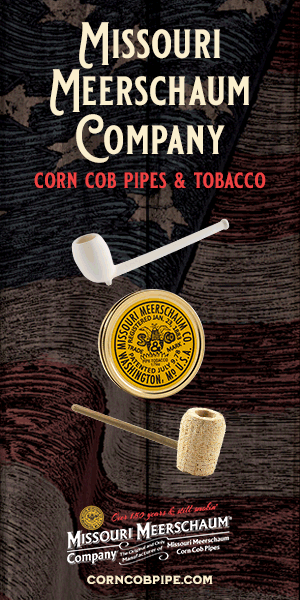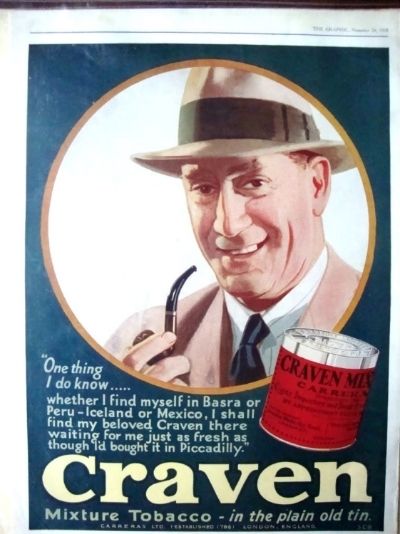




Carreras was quite the big player and I won't go into the intricate involved history,
but default to Wikipedia,
who gives a very good survey:
https://en.wikipedia.org/wiki/Carreras_Tobacco_Company
...of special interest to us pipesmokers was the merger with Rothmans,
which would come to affect PipeWorld in quite a dramatic fashion.
Alternatively,
this pdf provides a wonderful write up and is very well done:
http://www.jacobscane.org/images/LookListen/london/lon_ld/Carreras_family_firm_factory.pdf
Although Carreras is mainly known for their Craven Mixture, and their Craven "A" cigarettes,
they did offer other blends as well:








it was the infamous Craven Mixture which made their fortune and earned a rightful place in the pipeman's mythic baccylore.
Arno,
on his lovely blog,
did an exquisite write up:
https://dutchpipesmoker.wordpress.com/2013/05/11/i-crave-for-some-craven-mixture/
Yet,
it was way back when,
that an earlier enthused scribe wrote esoteric notes,
which lent an unrelinquished fame...

























mention must be made of Bernhard Baron.

He held quite a few patents related to his field.
Here is the very clever cartridge case and pipe filler designed circa 1910...
GB191005688
An Improved Pocket Case for Holding Tobacco Packets or Cartridges, Combined with a Pipe Filler
http://worldwide.espacenet.com/publicationDetails/biblio?DB=EPODOC&II=18&ND=3&adjacent=true&locale=en_EP&FT=D&date=19110223&CC=GB&NR=191005688A&KC=A




http://worldwide.espacenet.com/publicationDetails/biblio?DB=EPODOC&II=16&ND=3&adjacent=true&locale=en_EP&FT=D&date=19110615&CC=GB&NR=191111014A&KC=A
And now,
here we are at 1928,
when a new factory was built,
inwhich on the occasion of the opening which was attended by many prominent Britishers and 3,000 employees, Mr. Baron (who had started his career in the tobacco industry as a cigar maker in a New York factory) told the story of his life in the following concise sentences:
“I was born in Russia, at Brest-Litovsk. That was in 1850. I was taken as a child to Rostov-on-the-Don, and there I grew up among the Don Cossacks. I am really more of a Cossack than anything else. Then as a young man I went to America. I had nothing in my pocket when I got there.
However I got to work without any waiting-$4 a week-and saved $2.50 of them. I worked, oh, how I worked and I went on saving; every week I saved. I saved because I wanted independence; because I wanted to have a business of my own. I did not think then how great a business.
“After I had been thirty years in America, I came to England. I had invented a machine for making cigarettes. I brought it to England. Then I heard of a small tobacco business that was for sale. It was small, but it was not unknown. It was Carreras. It manufactured a pipe tobacco that Sir James Barrie had written about in his ‘Lady Nicotine.’ In 1903, I bought it, that Carreras firm.
For five years I made no profits. In the sixth year I made £163;11,000, and after that, well, every year more, until now. . .
“I advertised, advertised, advertised.
And now we turn out millions and millions and millions of cigarettes a day. Well, there is the story.
“Just a young man with nothing in his pocket and now this factory, 3,000 people employed-and happy-a million and a half pounds given away-all my family, sons, grandsons, rich,-and happy, and myself feeling now old, used up, tired, old, not well.”




















here are a few more advertisements...



















































GLPease has a great story about motoring with the Craven Mixture - I would love it if perchance he saw this thread and shared the story with us, but if not, I reckon I'll reprint it here at some point --- it really is an entertaining tale!
...and now,
off we go into the tinnery!




















































J.J.C. for José Joaquin Carreras.
And now,
a brief final sidenote,
about life and the happenstance thereof...
This is that tin:"Arthur Mann joined the Royal Flying Corps in 1914.
His daughter-in-law says he was shot down by the Red Baron, Manfred von Richthofen Arthur's parachute caught in a tree.
He also fought in the trenches when Arthur was shot, the bullet bounced off this tin and saved his life.
He also survived gassing, but this experience badly affected his long-term health. He died in 1953"



:










 :
: